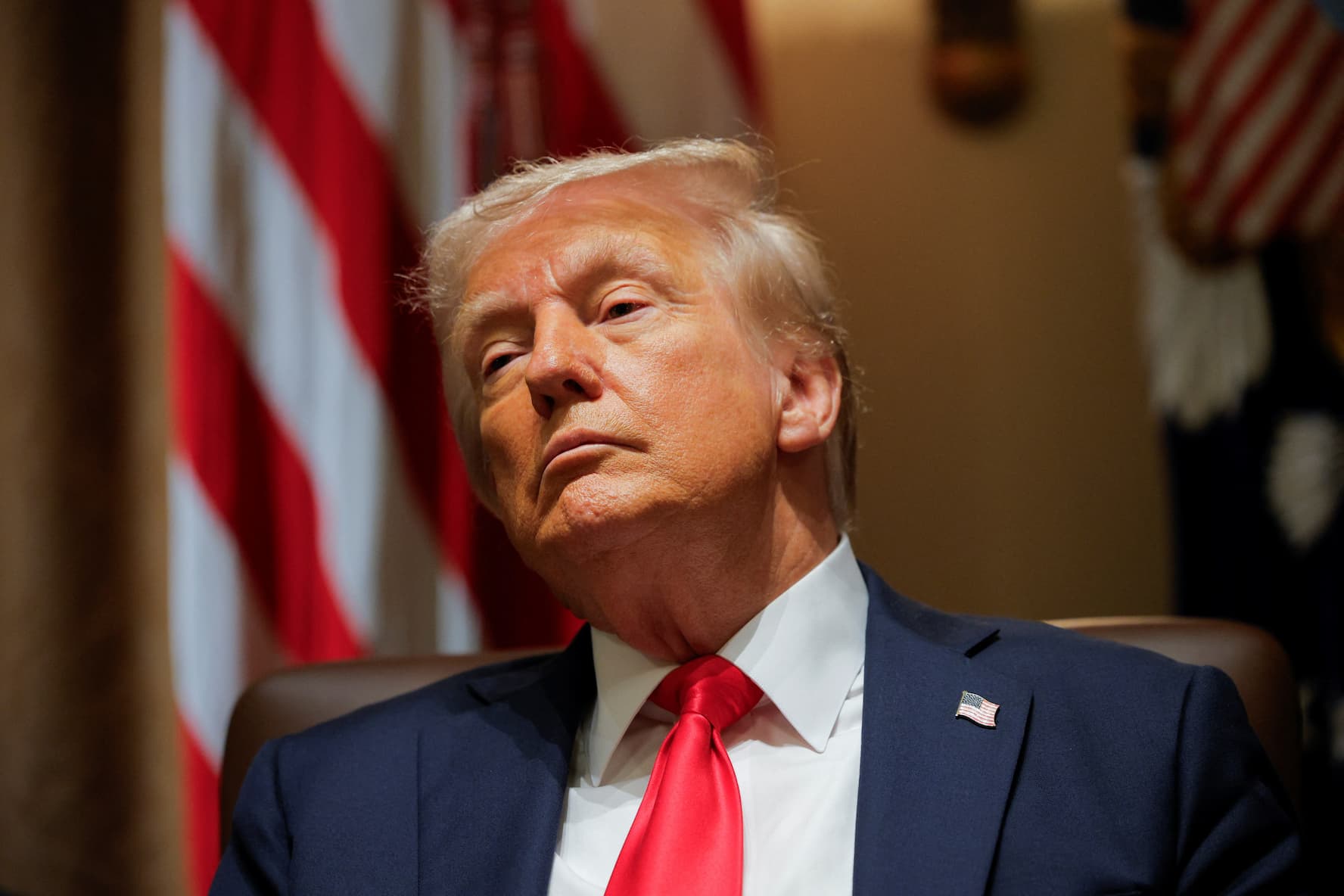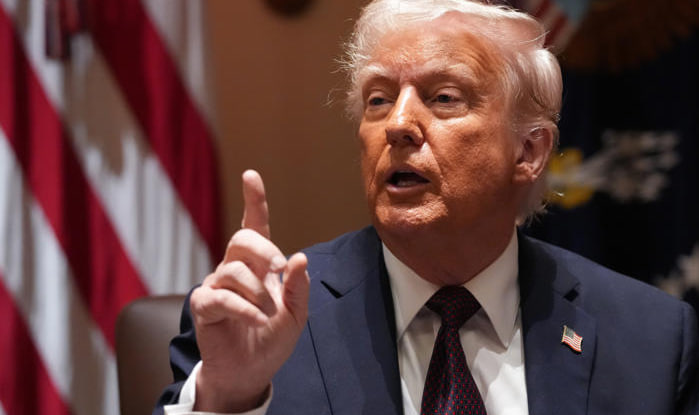Former President Donald Trump, now serving in his second term, is facing a complex political landscape just months into his return to the White House. As economic concerns persist and international tensions escalate, recent polling suggests that public confidence in his leadership has softened.
The data points to a country increasingly divided along political and ideological lines, with independent voters playing a pivotal role as the United States approaches the 2026 midterm elections.
National Approval Rating Falls Below Majority Threshold
According to recent polling data released by The Daily Boulder, President Trump’s job approval rating has declined to 45%, with 46% disapproving and 9% undecided. This marks a drop from 49% in January, representing a measurable shift in public sentiment.
Though a four-point dip may appear modest, political analysts note that the decline is significant, particularly given the historically narrow margins in recent elections. With more voters expressing dissatisfaction than support, the numbers reflect a broader national unease tied to both domestic policy and foreign affairs.
Economic Confidence Wanes
Economic challenges are a key factor behind the softening approval. Americans continue to express concern over rising costs of living, persistent inflation, and long-term economic stability. While the administration has taken steps to address these issues, including monetary policy adjustments and energy initiatives, public perception remains mixed.
A recent Emerson College poll found that 53% of Americans believe the country is heading in the wrong direction, while 48% feel it is on the right path. Though close, the margin underscores deep national divisions that could pose obstacles for Trump’s legislative agenda and re-election strategy.

Independent Voters Show Signs of Shifting
One of the most notable developments in recent polling involves independent voters — a group that has historically been critical to electoral outcomes. According to Emerson College, support among independents for Republican congressional candidates has fallen behind Democrats, with 37% favoring Democrats, 27% preferring Republicans, and 36% still undecided.
The high percentage of undecided independents indicates volatility within the electorate and suggests that both parties will need to make targeted appeals to gain traction before the midterms. For President Trump, regaining trust among this group may prove vital in maintaining control over key legislative priorities.

Texas Polling Reveals Localized Discontent
While national approval numbers are important, state-level polls often provide deeper insight into shifting political dynamics. A survey conducted by the Texas Politics Project in collaboration with the University of Texas revealed that President Trump’s approval rating in the state has dropped to 44%, while 51% of Texans disapprove of his performance.
This is especially notable given Texas’s strong Republican history and Trump’s past success in the state during both the 2016 and 2020 elections. The findings also highlight specific voter concerns in the state:
-
51% of Texans disapprove of Trump’s handling of the economy.
-
52% express dissatisfaction with his approach to inflation and cost-of-living issues.
While Trump retains strong support among Republican voters in Texas — with 87% approval among GOP respondents — that figure has slipped slightly from 89% recorded in April. Although the decline is small, it may indicate a broader trend of Republican voters expressing concern while still largely backing the former president.
International Tensions Add Complexity
Amid domestic challenges, President Trump is also navigating a series of significant international developments. Earlier this month, the administration launched a set of military actions targeting Iranian infrastructure in response to rising security threats. The situation escalated temporarily, resulting in retaliatory actions that included reported attacks on U.S. military installations in Iraq and Qatar.
Following these events, Trump helped facilitate a temporary ceasefire agreement between Iran and Israel. The negotiations, confirmed through official government channels, aimed to de-escalate tensions in the region and avoid further conflict.
While some observers have credited the ceasefire as a diplomatic success, others caution that the situation remains fragile and unresolved. Analysts note that any sustained improvement in international relations will require continued cooperation and measured policy responses.

Base Support Remains Strong
Despite falling approval among the general public, President Trump continues to hold strong support within his base. Most national surveys show that over 80% of Republican voters approve of his leadership, particularly on issues such as border security, defense, and crime prevention.
This loyal base remains a foundational asset for the Trump administration as it prepares for potential political headwinds in the coming year. However, analysts suggest that relying solely on base support may not be sufficient to maintain legislative control or win over swing states in 2026.

Outlook for the 2026 Midterms
As the country moves closer to the 2026 midterm elections, President Trump’s approval ratings may serve as a critical indicator of Republican momentum nationwide. With key battlegrounds in Florida, Arizona, Georgia, and even Texas showing signs of tighter margins, the Republican Party could face unexpected challenges.
Political strategists say that voter sentiment will likely be influenced by several factors over the next year, including:
-
Inflation and economic growth
-
Energy prices and job creation
-
Healthcare and education policy
-
National security and foreign relations
Any substantial gains in these areas could help shift public opinion. Conversely, setbacks could deepen disapproval and make it more difficult for Trump-aligned candidates to succeed in competitive districts.
The Importance of Moderates and Young Voters
In addition to independent voters, moderate conservatives and younger generations are emerging as key demographics in the next election cycle. Polling suggests that these groups are increasingly concerned about fiscal responsibility, climate policy, and the tone of political discourse.
Bridging this gap may require changes in messaging and more inclusive policymaking. Political observers note that younger voters are also more likely to support candidates who emphasize transparency, cooperation across party lines, and long-term economic planning.

Final Thoughts
While Donald Trump remains a prominent figure in American politics, his approval rating in 2025 reflects a more divided national mood. The combination of economic challenges and global uncertainty has created new hurdles for his administration, even as his base continues to show strong loyalty.
Whether the current dip in approval is temporary or a sign of broader political shifts remains to be seen. However, with the midterm elections on the horizon, the months ahead will be pivotal — not only for the future of Trump’s presidency but also for the direction of the Republican Party and the country as a whole.
Sources:
-
Emerson College Polling (https://emersoncollegepolling.com)
-
Texas Politics Project at the University of Texas (https://texaspolitics.utexas.edu)
-
The Daily Boulder Poll Report
-
Official U.S. government statements on Middle East negotiations


